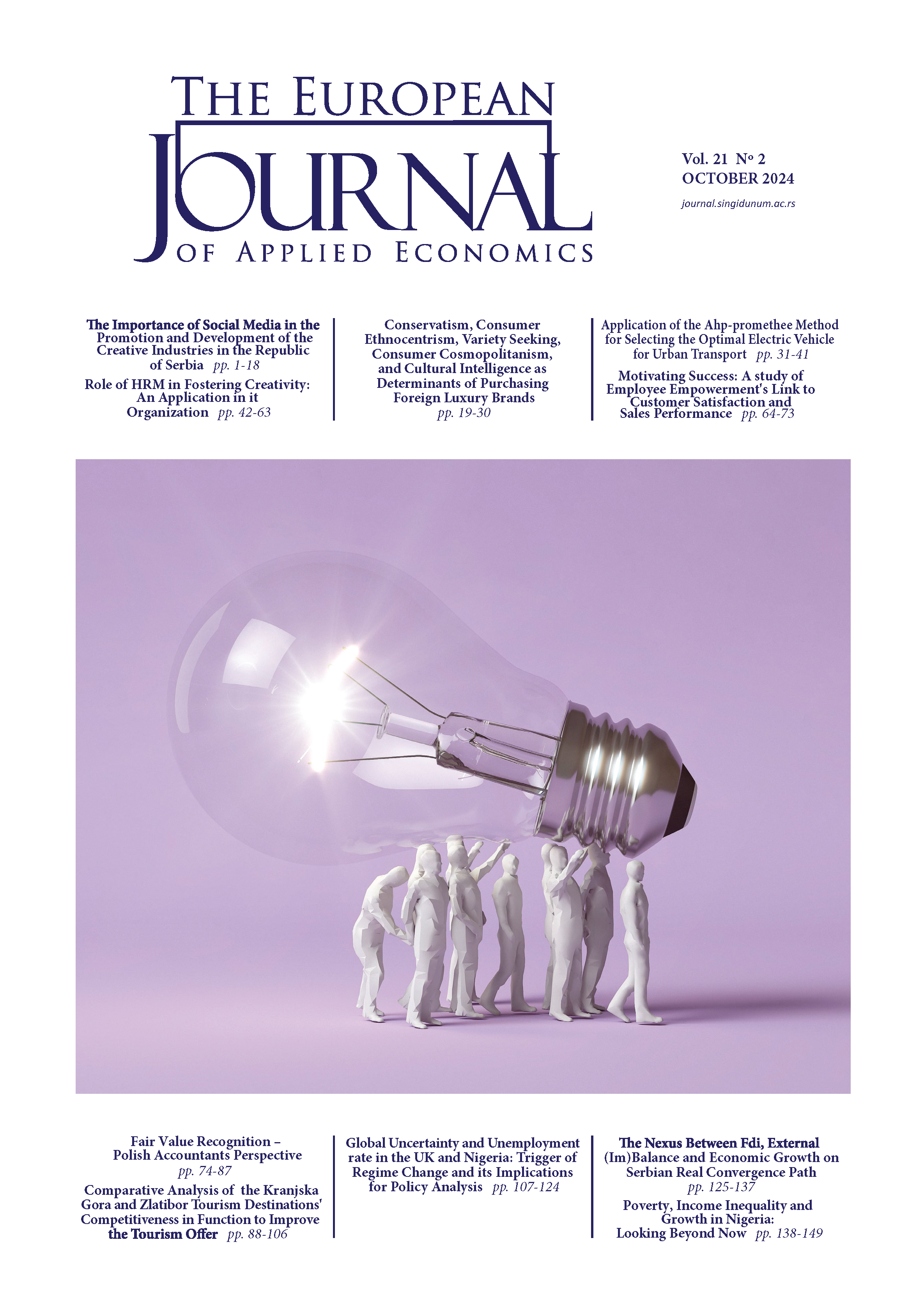COMPARATIVE ANALYSIS OF THE KRANJSKA GORA AND ZLATIBOR TOURISM DESTINATIONS' COMPETITIVENESS IN FUNCTION OF IMPROVING THE TOURISM OFFERCTION TO IMPROVE THE TOURIST OFFER - KRANJSKA GORA AND ZLATIBOR CASE STUDY
Abstract
The initial hypothesis of the work was the assumption that Zlatibor has potential for tourism development, but that the tourist destination Zlatibor is still not sufficiently competitive with the tourist destination Kranjska Gora. The research presents the key features of these areas, their attractive tourist offer, through a comparative analysis. Also, this paper deals with the chances for the development of sustainable tourism, as well as the improvement of tourist services, specifically Zlatibor, bearing in mind that the Kranjska region is in a much better position, as far as the implementation of the concept of green tourism development. The research was conducted using a modified IMDC model, seeking responses from stakeholders from both Zlatibor and Kranjska Gora (259). Bearing in mind that the responses of stakeholders from Slovenia showed consistently higher values in the assessment of destination competitiveness, the starting hypothesis proved to be correct, and in response to that, guidelines were given for improving competitiveness and overcoming certain threats observed in the research results.
References
2. Armenski, T., Gomezelj, D., Djurdjev, B., Ćurčić, N., Dragin, A. (2012). “Tourism destination competitiveness - Between two flags”. Economic Research, 25, doi:10.1080/1331677X.2012.11517519.
3. Beguš, J., Mertelj, J., & Škrjanec, S. (2021). Kranjska Gora Pilot Action Region: Environmentally-Friendly Construction of the Planica Nordic Centre. In Best Practice Examples of Implementing Ecosystem-Based Natural Hazard Risk Management in the GreenRisk4ALPs Pilot Action Regions. IntechOpen.
4. Chen, J., Huang, Y., Wu, E. Q., Ip, R., & Wang, K. (2023). How does the rural tourism experience affect green consumption in terms of memorable rural-based tourism experiences, connectedness to nature and environmental awareness?.Journal of Hospitality and Tourism Management, 54, 166-177.
5. Chin, C.H., Lo, M.C., Songan, P., Nair, V. (2014) “RuralTourism Destination Competitiveness: AStudy on Annah Rais Longhouse Homestay, Sarawak”. Procedia - Social and Behavioral Sciences, 144-20.
6. Dragićević, V., Jovičić, D., Blešić, I., Stankov, U., Bošković, D. (2012). “Business tourism destination competitiveness: A case of Vojvodina Province (Serbia). Economic Research 25. doi: 10.1080/1331677X.2012.11517510.
7. Dwyer, L., Kim, C. (2003). “Destination competitiveness: Determinants and indicators”. Current Issues in Tourism 6.
8. Dwyer, L., Knežević Cvelbar, Lj., Edwards, D., Mihalic, T. (2012). “Fashioning A Destination Tourism Future: The Case Of Slovenia”. Tourism Management33-2. doi:10.1016/j.tourman.2011.03.010.
9. Dwyer, L., Mellor, R., Livaic, Z., Edwards, D., Kim, C.W. (2004). “Attributes of destination competitiveness: A factor analysis. Tourism Analysis 9.
10. Gomezelj, O. D., Mihalič, T. (2008) “Destination competitiveness - Applying different models, the case of Slovenia”. Tourism Management 29-2. doi:10.1016/j.tourman.2007.03.009
11. Grum, B., Kobal Grum, D. (2014). “Satisfaction with current residence status in comparison with expectations of real estate buyers in Slovenia and Serbia”. Procedia - Social And Behavioral Sciences109-8.
12. Ilić, P., Ivković Zlatić, Z. (2014). Zlatibor kroz kulturu i turizam, Turistička organizacija Zlatibor, Zlatibor;
13. Konecnik Ruzzier, M., & Petek, N. (2012). Country brand I feel Slovenia: First response from locals. Economic research-Ekonomska istraživanja, 25(2), 465-484;
14. Nunkoo, R., & Ramkissoon, H. (2012). Power, trust, social exchange and community support. Annals of Tourism Research, 39(2), 997–1023. https://doi.org/10.1016/j. annals.2011.11.017
15. Nerad, A., Biloslavo, R., Jurincic, I., & Koscak, M. (2020). Sustainable Destination Management Planning: The Case of Slovenia. In MIC 2020: The 20th Management International Conference (pp. 85-99). University of Primorska Press;
16. Petrick, M., Gramzow, A. (2012). Harnessing Communities, Markets and the State for Public Goods Provision: Evidence from Post-Socialist Rural Poland. World Development, 40 (11), pp. 2342–2354
17. Petrović, M., Blešić, I., Vujko, A., Gajić, T. (2017). The role of agritourism impact on local community in a transitional society: a report from Serbia. Transylvanian Review of Administrative Sciences, 50/2017
18. Quaranta, G., Citro, E., & Salvia, R. (2016). Economic and social sustainable synergies to promote innovations in rural tourism and local development. Sustainability, 8(7), 668.
19. Savoiu, G., Taicu, M. (2014). Foreign Direct Investment Models, Based on Country Risk for Some Post-Socialist Central and Eastern European Economies. Procedia Economics and Finance, Vol. 10, pp. 249 – 260
20. Stanišić, M., Čačić, K. (2007). Poslovni (master) plan turističke destinacije Zlatibor-Zlatar, Beograd;
21. Šprah, L., Novak, T., Fridl, J. (2014). “The wellbeing of Slovenias population by region: comparison of indicators with an emphasis on health”. Acta geographica Slovenica 54-1. doi: ttp://dx.doi.org/10.3986/AGS54104
22. Vujko, A., Gajić, T. (2014). The gouverment policy impact on economic development of tourism. Ekonomika poljoprivrede., 61(3), pp. 789-804
23. Vujko, A., Petrović, M., Dragosavac, M., Gajić, T. (2016). Differences and similarities among rural tourism in Slovenia and Serbia - perceptions of local tourism workers. Ekonomika poljoprivrede, 4/2016, 1459-1469
24. https://www.slovenia.info/en/places-to-go/regions/alpine-slovenia/kranjska-gora (posećeno dana: 15.03.2024.);


